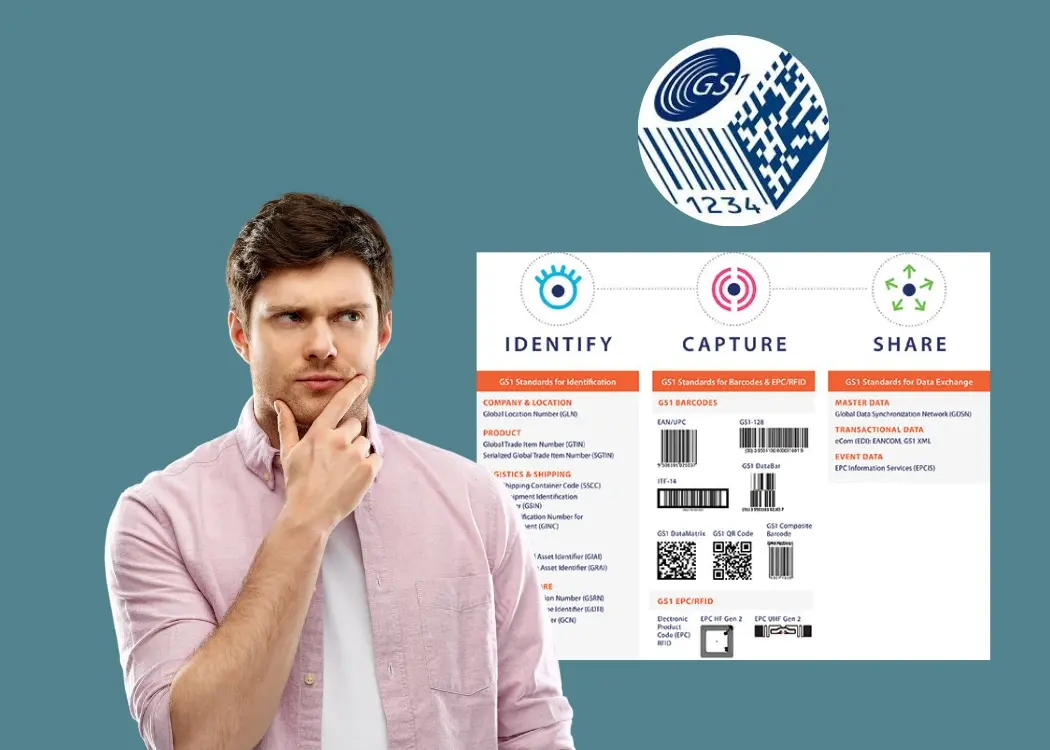How to simplify artwork tracking in complex packaging projects
When you're managing a packaging design project, especially across different product lines, regions, and teams, things can quickly spiral out of...
4 min read
Ekaterina Skalatskaia
:
May 28, 2025 7:15:00 AM

When you walk through a supermarket, every product on every shelf has something in common: a barcode. But behind that simple black-and-white pattern lies a powerful global standard that connects manufacturers, suppliers, retailers—and yes, packaging designers. That standard is called GS1.
In this article, we’ll break down what GS1 standards are, why they matter in packaging design and artwork creation, and how tools like Cway® help ensure compliance at every step of the packaging workflow.
GS1 is a global organization that develops and maintains standards for supply chains across industries. The most familiar of these standards is the GS1 barcode, but GS1 governs much more than that—including identifiers for trade items, logistics units, locations, and digital data exchange.
In the context of FMCG and retail, GS1 standards provide a common language for everyone involved in the production and distribution of products. These standards ensure that when a product is scanned, tracked, or stored, it’s handled accurately and efficiently—regardless of where it was made or who sells it.
Discover how leading brands streamline packaging artwork, approvals, and file management—all in one platform.
This is the core document that outlines how GS1 barcodes and identifiers must be used on packaging. It includes everything from barcode placement and size to color and quiet zones.
Minimum barcode size (EAN/UPC): 80% magnification
Maximum size: 200% magnification
Quiet zones (white space): Minimum 2.5mm on both sides of barcode
Barcode placement: Should be on the lower right of the back of the package, ideally on a flat surface to ensure reliable scanning
Print contrast: Barcode should be printed in black on white background or a high-contrast equivalent
A GTIN is a unique number assigned to every product and packaging variation. It’s what the barcode represents and must be printed clearly and correctly embedded in the artwork.
GTIN-13: Common in retail, especially Europe
GTIN-14: Used for outer cartons or logistics units
GTIN-12: Common in North America (UPC codes)
Correct GTIN usage ensures that each product and variant is uniquely identifiable in global supply chains and is critical for accurate data sharing.
Different packaging levels require different types of barcodes:
|
Packaging Level |
Barcode Type |
Description |
|---|---|---|
|
Retail unit |
EAN-13 / UPC-A |
Standard barcode scanned at checkout |
|
Carton / Case |
ITF-14 or GS1-128 |
For logistics and warehouse scanning |
|
Pallet |
GS1-128 with SSCC |
Serialized shipping container code📖 Explore barcode types: https://www.gs1.org/barcodes |
GS1 Digital Link is the next generation of barcodes—often encoded into 2D codes (like QR codes)—that combine GTINs with web URLs. These allow consumers and supply chains to access real-time product data online.
Replaces need for multiple codes (QR + EAN)
Enables traceability, sustainability info, expiration dates, recall notices, etc.
Fully compatible with GS1 identifiers
GS1 also enforces standards around how items are structured across packaging hierarchies—from single units to cases and pallets. Every level must have the right GTIN and associated barcode.
Explore our powerful packaging workflow tools—no strings attached. Start optimizing your artwork process today.
In real-world packaging design, it’s not unusual to manage:
Dozens or hundreds of SKUs
Multiple product lines with varied pack formats
Multilingual copy
Regional and regulatory variations
Ensuring GS1 compliance across all these variables is time-consuming and error-prone—especially when managed with generic tools like spreadsheets or static PDFs.
Packaging and artwork teams often struggle to:
Track which GTIN is assigned to which SKU
Ensure the correct barcode version is used
Coordinate barcode placement with designers and printers
Verify that the final design meets print specifications for scannability
Get Access to Your Cway® Workspace
Fill out a quick form to request your account and start collaborating on packaging artwork with your team.
Cway® simplifies the process of managing GS1 standards in packaging projects by combining project management, file collaboration, and visual review tools in one powerful platform.
All packaging artworks are stored and versioned in Cway’s Media Center App, ensuring that barcode data and artwork files are always aligned. This avoids mix-ups between versions or regions.
Cway’s powerful Viewer allows users to:
Review barcode placement directly on the artwork
Compare multiple versions side-by-side
Leave comments for corrections or updates—right on the file
This visual feedback loop ensures that GS1-related elements like GTINs and barcodes are never overlooked during reviews.
Multiple stakeholders—regulatory, marketing, design, supply chain—can work together in one structured system. Cway lets you define approval flows that include GS1 checks as part of the process.
In today's fast-moving, global packaging landscape, GS1 standards ensure consistency, traceability, and efficiency—from factory floor to store shelf. But compliance doesn't happen automatically—it must be built into your packaging workflow from the start.
With Cway®, teams can manage GS1 standards as part of their daily packaging operations—without losing time, control, or visibility.
GS1 standards are globally recognized guidelines used to identify, capture, and share product information throughout the supply chain. In packaging, they ensure that product barcodes, GTINs, and related data are consistent, scannable, and compliant with global retail systems.
GS1 standards define how information like barcodes and product identifiers (GTINs) must appear on packaging. Following these standards helps ensure retail compliance, avoids scanning errors, and prevents costly packaging reprints or delays during product launches.
GTIN stands for Global Trade Item Number. It’s a unique code used to identify individual products or packaging levels (unit, case, pallet). GTINs are encoded in barcodes and printed on packaging to ensure accurate product tracking and sales across supply chains.
Common barcode types include:
EAN-13 / UPC-A – for retail items scanned at checkout
ITF-14 or GS1-128 – for cartons and shipping cases
GS1-128 with SSCC – for pallets and logistics tracking
Each barcode type must follow strict sizing, color, and placement rules defined in the GS1 General Specifications.
GS1 Digital Link is a new standard that embeds GS1 identifiers (like GTINs) into 2D barcodes (such as QR codes). It allows packaging to link directly to digital content—like product details, traceability info, or marketing pages—while remaining GS1-compliant.
Non-compliance can result in:
Barcodes that don’t scan
Retailer rejections or returns
Regulatory issues
Lost sales or delays
Using proper barcode placement, sizing, and valid GTINs during the artwork phase is essential to avoid these risks.
When you're managing a packaging design project, especially across different product lines, regions, and teams, things can quickly spiral out of...

Automated artwork management is transforming how brands, agencies, and printers manage their packaging design process. In this article, we explore...

Packaging mistakes cost global brands billions every year — in recalls, redesigns, delays, and lost shelf space. That's why more and more companies...